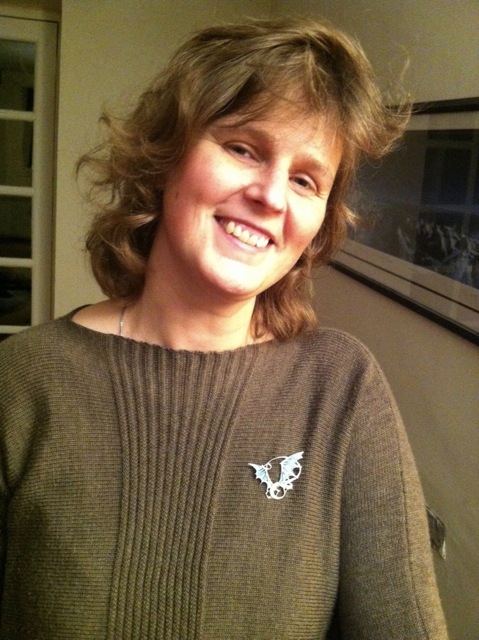Dr Lucy Rogers
From hacking robotic dinosaurs to helping spacecraft avoid being hit by rubbish, the Inspirefest 2015 speaker is putting her talents for science, engineering and communication to wide use.
When Dr Lucy Rogers is asked that inevitable dinner-party question ‘what do you do?’ she has an array of answers to hand. “I play with robot dinosaurs,” she explains. “And when not doing that I am working out the probability of spacecraft getting hit by space debris and I turn science into plain English.”
Robot dinos
Robot dinosaurs seems like a good place to start – Rogers has been ‘hacking’ installations at the Blackgang Chine Theme Park on the Isle of Wight, where fibreglass dinosaurs were famously winched in, as covered by the children’s TV programme Blue Peter. More recently, the dinosaurs have been revamped and Rogers was asked to work on making the robotics elements more programmable.
“They asked me to come in and hack the dinosaurs,” she says. “They want them to do what they want when they want it, rather than a pre-programmed set of routines.”
Rogers set to work with the Raspberry Pi computer to control the electronics and replace parts that had broken. “You can’t wait six weeks for a new part to arrive when you are mid-holiday season,” she says. “You have to fix it now.”
Through workshops she trained staff to use the drag-and-drop programming language Node RED to put in their own instructions, and she is continuing to work with the theme park on making the exhibits more lively. “If they want all the dinos to roar a quarter of an hour before closing, they can now programme them to do that,” she says.
.jpeg) Watch out for space debris
Watch out for space debris
And what about space? While on a graduate programme at Singularity University in 2011, Rogers developed an interest in space debris – the bits of artificial ‘junk’ that orbit Earth and pose a potential hazard to working spacecraft, which tend to travel along common paths in their orbits. “We basically use motorways in space, and they are particularly busy at the (North and South) poles,” she explains.
Today, to help manufacturers and insurers better understand the risks of spacecraft being pelted and potentially damaged by space debris, Rogers uses data available from the European Space Agency to calculate the probability of those collisions.
“They want to know which orbit they should go in, how long should they stay up there and should they be at 200km or 600km,” she says. “They want to know how much shielding have they got to put on or can they go to areas that it is just safe because other spacecraft don’t go there.”
Inspiring bubbles
Rogers started on her career path when she studied mechanical engineering at Lancaster University, inspired by wanting to create ‘Heath Robinson’ contraptions and the animated puppets on the satirical TV programme Spitting Image. But animatronics would wait while she went on to study design, manufacture and management and did her PhD on how bubbles are formed in equipment to fight petrochemical fires.
Working with a company that made a kit to spray foam from a distance onto burning oil rigs and smother the fire, she modelled how bubbles formed in the foam. “They knew the kit worked but not how the bubbles were forming,” Rogers explains. “And the smaller the bubbles the further you can throw it, but the smaller the bubbles the higher the drainage rate so (the foam) disappears quicker.”
For her research, Rogers built a scaled-down version of the nozzle and analysed high-speed video footage to discover that the bubbles were being made in various ways, and this opened up opportunities for more control over the process.

Talent for science communication
While filling out a VAT return, Rogers set herself on another path too – this time as a science communicator. “I was so bored by doing the return, I checked my email and saw the British Association for the Advancement of Science (now the British Science Association) were offering media fellowships (where scientists spend time with media organisations) and I applied.”
That resulted in Rogers spending weeks at The Guardian. Under the watch of science journalist Tim Radford, who was characteristically generous with advice, she wrote articles, accrued bylines and enjoyed the process. “It just turned out that I enjoyed doing it and I had a knack for it already,” she recalls.
Since then, Rogers has written for other media outlets and she has penned a book: It’s ONLY Rocket Science: An Introduction in Plain English (Astronomers’ Universe).
Engineering diversity
Looking forward to Inspirefest 2015 in June, where she will most likely speak about “space or the Internet of Things”, Rogers is keen to promote diversity in engineering. “I think that making engineering more accessible to everybody is s good thing,” she says.
“Whether I am appealing to men, women, girls or boys it doesn’t really matter. “(I want) people to see me doing it and realise that engineering doesn’t have to be about climbing under a car or going down a coal mine – it can be playing with robot dinosaurs, it can be playing with space, it can be getting things to do what we want them to do.”
Women Invent is Silicon Republic’s campaign to champion the role of women in science, technology, engineering and maths. It has been running since March 2013, and is kindly supported by Accenture Ireland, Intel, the Irish Research Council, ESB, Twitter, CoderDojo and Science Foundation Ireland.
Inspirefest 2015 is Silicon Republic’s unique international sci-tech event running 18-19 June in Dublin, connecting professionals passionate about the future of STEM with fresh perspectives on leadership, innovation and diversity. Buy your early bird tickets now! Get in early and grab the ‘Two-for-one’ tickets before the end of March. You don’t want to miss this!